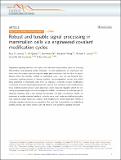Robust and tunable signal processing in mammalian cells via engineered covalent modification cycles
Author(s)
Jones, Ross D; Qian, Yili; Ilia, Katherine; Wang, Benjamin; Laub, Michael T; Del Vecchio, Domitilla; Weiss, Ron; ... Show more Show less
DownloadPublished version (1.988Mb)
Publisher with Creative Commons License
Publisher with Creative Commons License
Creative Commons Attribution
Terms of use
Metadata
Show full item recordAbstract
<jats:title>Abstract</jats:title><jats:p>Engineered signaling networks can impart cells with new functionalities useful for directing differentiation and actuating cellular therapies. For such applications, the engineered networks must be tunable, precisely regulate target gene expression, and be robust to perturbations within the complex context of mammalian cells. Here, we use bacterial two-component signaling proteins to develop synthetic phosphoregulation devices that exhibit these properties in mammalian cells. First, we engineer a synthetic covalent modification cycle based on kinase and phosphatase proteins derived from the bifunctional histidine kinase EnvZ, enabling analog tuning of gene expression via its response regulator OmpR. By regulating phosphatase expression with endogenous miRNAs, we demonstrate cell-type specific signaling responses and a new strategy for accurate cell type classification. Finally, we implement a tunable negative feedback controller via a small molecule-stabilized phosphatase, reducing output expression variance and mitigating the context-dependent effects of off-target regulation and resource competition. Our work lays the foundation for establishing tunable, precise, and robust control over cell behavior with synthetic signaling networks.</jats:p>
Date issued
2022Department
Massachusetts Institute of Technology. Department of BiologyJournal
Nature Communications
Publisher
Springer Science and Business Media LLC
Citation
Jones, Ross D, Qian, Yili, Ilia, Katherine, Wang, Benjamin, Laub, Michael T et al. 2022. "Robust and tunable signal processing in mammalian cells via engineered covalent modification cycles." Nature Communications, 13 (1).
Version: Final published version